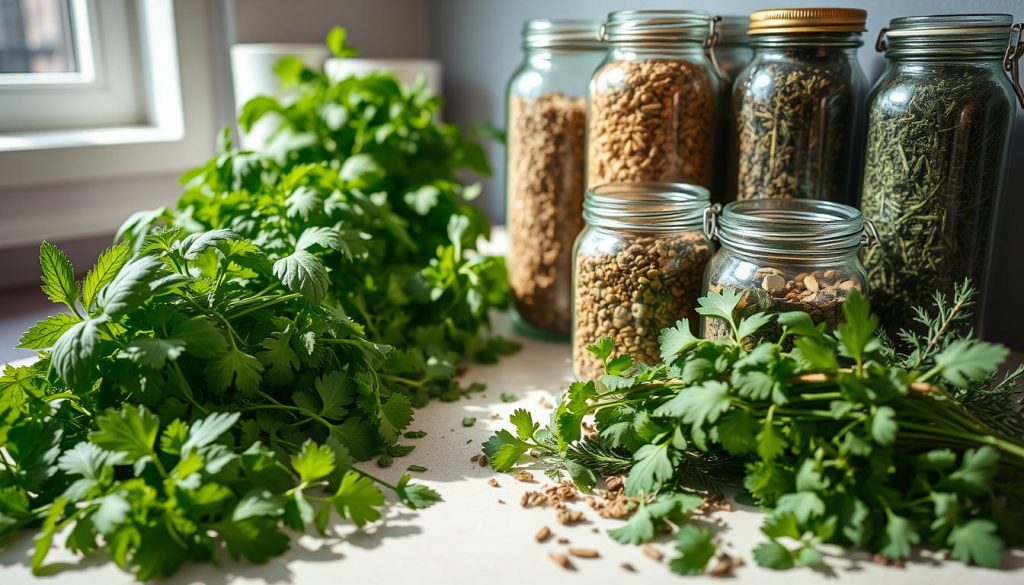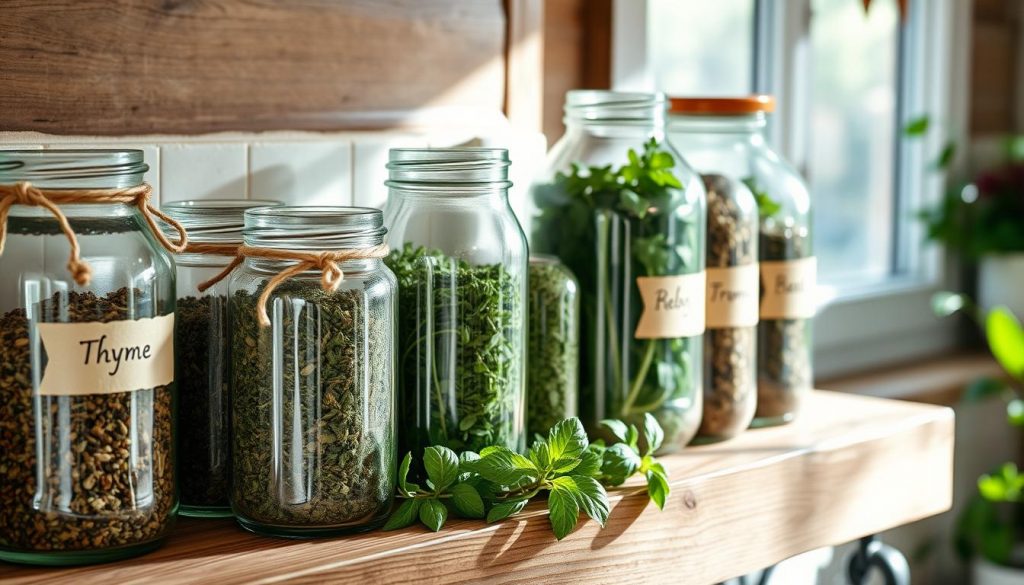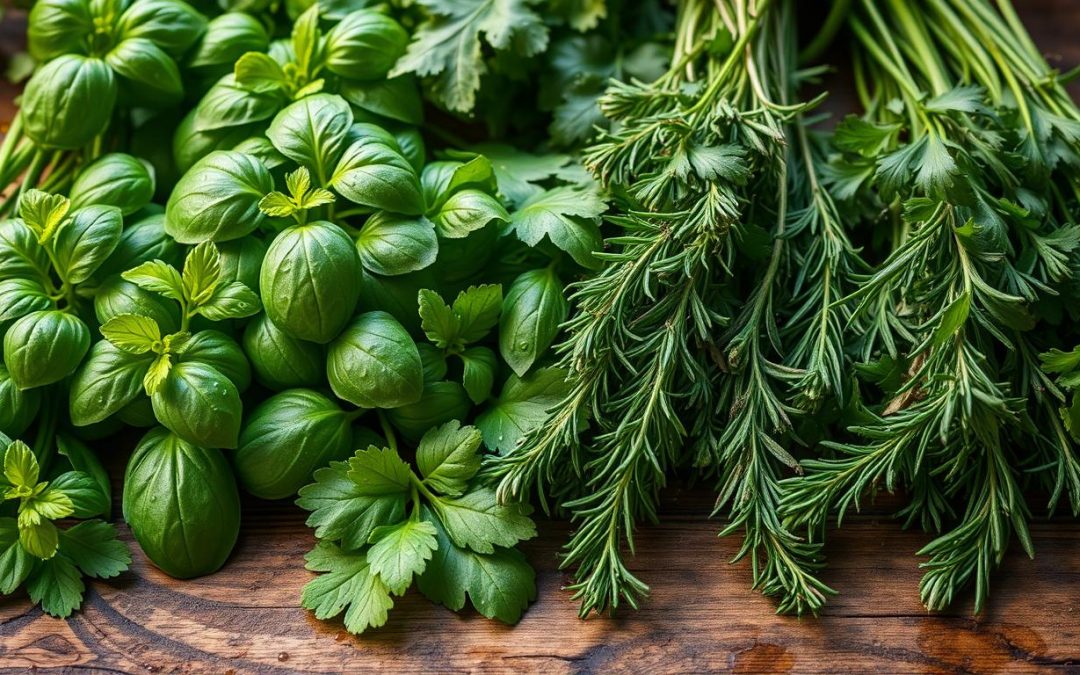When we talk about herbs, a big question is: what makes fresh herbs different from dried ones? We’ll look into the differences between fresh and dried herbs. Fresh herbs are known for their vibrant flavors. They are key in Mediterranean, Southeast Asian, and Latin American cooking, where bold and fresh tastes are important1. For more on fresh versus dried herbs, check out fresh versus dried herbs for a detailed look.
Knowing the differences between fresh and dried herbs can make our cooking better. In this article, we’ll give you a detailed guide. We’ll focus on flavor and usage, and compare fresh and dried herbs. This will help you choose the right herbs for your cooking, making your dishes even more delicious.
Table of Contents
Key Takeaways
- Fresh herbs add bright, fresh flavors to dishes, while dried herbs have a more concentrated flavor.
- A general rule of thumb for substituting dried herbs for fresh is a 3:1 ratio; 1 part dried herbs is equivalent to 3 parts fresh herbs1.
- Fresh herbs should be stored in a refrigerator wrapped in a damp paper towel and placed in a plastic bag1.
- Dried herbs are recommended for marinades and dry rubs due to their concentrated flavor and texture1.
- Fresh herbs are essential in raw preparations, contributing unique flavors that cannot be replicated by dried herbs1.
- Dried herbs can last technically for years but start losing flavor after about three months2.
Understanding Fresh Herbs in Cooking
Fresh herbs like parsley, tarragon, and chives are best used right away. They lose flavor when dried3. We’ll look at the different types of fresh herbs, their benefits, and how to pick and store them. Adding fresh herbs to your dishes can really enhance their taste.
Some top herbs to use fresh are basil, dill, cilantro, mint, and parsley3. These herbs add a burst of flavor to your meals. They’re best added towards the end of cooking to keep their taste and texture.
To keep your fresh herbs fresh, follow some key tips. Store them in a cool, dry spot, or wrap them in a damp paper towel4. These methods help preserve their flavor and nutrients.
Some herbs, like parsley and basil, are best used fresh. Others, like rosemary and thyme, can be dried5. Knowing how to use different herbs can make your dishes more flavorful. Experiment with both fresh and dried herbs to find your favorites.
Exploring Dried Herbs
Understanding the difference between fresh and dried herbs is key in cooking. Dried herbs like oregano, thyme, and rosemary pack a stronger flavor. They’re perfect for slow-cooked meals6. To use them right, remember to use one-third the amount of dried herbs as you would fresh7.
Using dried herbs well means knowing how to enhance their taste. Dried herbs shine in slow cooking, like dishes that simmer for over 45 minutes6. This method lets the herbs rehydrate and release their full flavor. Favorites include basil, rosemary, and thyme.
Proper storage is key to enjoying your dried herbs. They can last up to 1 year in a cool, dry spot6. This makes them ideal for meal prep. Learning to use dried herbs effectively opens up new flavors in your cooking.
Key Flavor Differences Between Fresh and Dried Herbs
Fresh herbs taste bright and fresh, while dried herbs have a deeper, earthier flavor8. This is because drying herbs concentrates their flavor by removing water5. Dried herbs, in particular, have a spicier taste due to this drying process5.
To get the most out of fresh herbs, add them towards the end of cooking. They can lose flavor quickly8. Dried herbs, on the other hand, should be added early to let their flavors blend into the dish8. Remember, use 3 times as much fresh herb as dried herb, so 1 tablespoon of fresh equals 1 teaspoon of dried8.
Here’s a quick guide to the main differences between fresh and dried herbs:
| Herb Type | Flavor Profile | Usage |
|---|---|---|
| Fresh Herbs | Bright, fresh flavor | Add close to the end of cooking |
| Dried Herbs | Concentrated, earthy flavor | Add earlier in the cooking process |
Knowing the flavor differences between fresh and dried herbs helps you choose the right one for your dishes. This way, you can enhance your cooking with the best flavors9.
Culinary Applications for Fresh Herbs
Using fresh herbs in cooking can really boost your dishes. Herbs like basil, mint, and cilantro are perfect for salads, sauces, and marinades10. For example, basil is essential in pesto, while mint is great in salads and drinks. To keep herbs fresh, store them in a cool, dry spot11.
Knowing how to swap fresh herbs for dried ones is key. A good rule of thumb is to use 3 parts fresh for every 1 part dried10. So, if a recipe asks for 1 teaspoon of dried herbs, use 3 teaspoons of fresh. Herbs like rosemary and thyme can be used both fresh and dried, but the taste and smell might differ10.
Here are some tips to make the most of your fresh herbs:
- Introduce fresh herbs towards the end of cooking to keep their taste and smell11.
- Keep fresh herbs in a sealed container in the fridge to keep them fresh for up to 2 weeks11.
- Try mixing different fresh herbs to find the perfect flavor for your dishes.
By following these tips and learning about cooking with fresh herbs, you can add more taste and freshness to your meals. Whether you’re an experienced chef or just starting out, fresh herbs can transform your cooking10.
Culinary Applications for Dried Herbs
Using dried herbs in cooking is all about knowing how to do it right. It’s important to understand the difference between fresh and dried herbs. This knowledge helps you use them well in different dishes. Herbs like thyme, rosemary, and oregano are perfect for soups, stews, and braises. They keep their flavor even after long cooking times12.
To use dried herbs effectively, you need to know the right amounts. A 3-to-1 ratio works for most herbs, like cilantro, dill, oregano, rosemary, and thyme13. So, 1 tablespoon of fresh herbs is equal to 1 teaspoon of dried ones. Also, for ground dried herbs, use a 4-to-1 ratio. This means 1 tablespoon of fresh herbs is equal to 3/4 teaspoon of ground dried herbs13.
Some popular dishes that benefit from dried herbs include:
- Soups and stews, where dried herbs like thyme and rosemary can add depth and warmth12
- Braises, where the long cooking time allows dried herbs to infuse their flavors into the dish
- Marinades and rubs, where dried herbs like oregano and basil can add a burst of flavor to meats and vegetables
By understanding how to use dried herbs effectively and knowing the difference between fresh and dried herbs, you can elevate your cooking. You can make delicious dishes with ease. For more information on cooking with herbs, visit cooking tips and reviews to learn more about the art of cooking with spices and herbs.
| Herb | Fresh to Dried Conversion |
|---|---|
| Thyme | 1 tablespoon fresh = 1 teaspoon dried |
| Rosemary | 1 tablespoon fresh = 1 teaspoon dried |
| Oregano | 1 tablespoon fresh = 1 teaspoon dried |
Fresh Herbs vs. Dried Herbs: Nutritional Value
Fresh and dried herbs have different nutritional values. Fresh herbs are packed with vitamins and minerals. Dried herbs, on the other hand, have more antioxidants.
For example, fresh basil is a powerhouse of nutrition. It has 8% of the daily value for vitamin C, 30% for vitamin A, and 145% for vitamin K per ounce14. Dried basil, while less potent, offers 2% of DV for vitamin C, 4% for vitamin A, and 43% for vitamin K per equivalent amount14.
Fresh herbs are like leafy greens, full of vitamins A, C, and K15. They also have polyphenols, which are good for you. Polyphenols help fight off diseases like cancer and heart disease15.
To get the most from your herbs, it’s key to know the difference between fresh and dried. Our guide to fresh vs. dried herbs can help you use them best.

Here are some key points to consider when choosing between fresh and dried herbs:
- Fresh herbs have a shorter shelf life compared to dried herbs, which can last at least one year when sealed properly14.
- The suggested ratio for substituting fresh herbs for dried herbs is 3:1 (3 parts fresh to 1 part dried)14.
- Fresh herbs should ideally be used soon after harvesting to maintain their nutritional value and flavor14.
Knowing the nutritional value of fresh and dried herbs helps you choose the best for your cooking. This way, you can enjoy the most benefits from using fresh herbs.
Storage Tips for Fresh Herbs
Knowing the best ways to store fresh herbs can make a big difference. You can keep them in the fridge or freeze them to make them last longer16. Herbs like parsley and cilantro can stay fresh for 3 weeks. Dill and mint can last about 2 weeks16. It’s important to store them right to keep their taste and smell.
To keep herbs fresh, it’s key to keep them moist. For soft herbs like cilantro and parsley, store them in water with a cover17. For tougher herbs, wrap them in a damp paper towel in a bag16. These tips help you enjoy fresh herbs in your cooking for longer.
Some important things to remember when storing herbs include:
- Keep herbs in the fridge at a steady temperature to stop them from rotting16.
- Use a sharp knife to cut herbs to release more oils and flavor17.
- Wash herbs before storing to make them last longer16.
By following these tips, you can enjoy the taste and smell of fresh herbs in your cooking for a longer time.
Storage Tips for Dried Herbs
Storing dried herbs right is key to keeping their taste and strength. Keep them in a cool, dry spot, away from sunlight and moisture. This keeps their natural oils and flavors fresh for longer18.
Use airtight containers like glass jars to keep them fresh. This stops air and moisture from getting in. Dried herbs lose flavor and smell if they get too much air19. They need special care because they can’t handle moisture and light like fresh herbs do.
Here are some tips for storing dried herbs:
- Keep them in a cool, dry spot, like a pantry or cupboard
- Use airtight containers, such as glass jars, to protect them from air and moisture
- Keep them away from direct sunlight and heat sources
- Label the containers with the herb name and date of storage to ensure you use the oldest herbs first
By following these tips, you can keep your dried herbs flavorful and strong. This makes them a great addition to your cooking20.
For more tips on drying and storing herbs, check out this resource. It has the best advice for keeping your herbs fresh.

| Herb | Storage Life | Optimal Storage Conditions |
|---|---|---|
| Dried Basil | Up to 1 year | Cool, dry place, away from direct sunlight |
| Dried Rosemary | Up to 1 year | Cool, dry place, away from direct sunlight |
How to Substitute Fresh Herbs for Dried Herbs
Understanding the difference between fresh and dried herbs is key in cooking. The ultimate guide to fresh vs. dried herbs will teach you how to swap them. To replace fresh herbs with dried, use 1/3 of the amount called for in the recipe21. So, if a recipe asks for 1 tablespoon of fresh herbs, use 1 teaspoon of dried herbs.
It’s also important to know how to use dried herbs effectively. Dried herbs are stronger than fresh ones, so you need less of them. Use one-third the amount of dried herb as you would fresh herb in a recipe21. For instance, if a recipe calls for 1 tablespoon of fresh sage, use 1 teaspoon of dried sage.
General Rules for Substitution
Here are some general rules for swapping fresh herbs for dried herbs:
- Use 1/3 of the amount of dried herbs compared to fresh herbs21.
- Start with a small amount of dried herbs and adjust to taste22.
- Consider the flavor profile of the herb and adjust the amount as needed22.
For more cooking and baking tips, visit cooking tips and reviews. Learn the best techniques and ingredients for your recipes.
Cooking Techniques: Fresh vs. Dried Herb Incorporation
When cooking with fresh and dried herbs, when you add them matters a lot. Fresh herbs should be added near the end of cooking. This helps keep their flavor and aroma23. Dried herbs, on the other hand, should go in at the start. This lets their flavors spread throughout the dish23.
Fresh herbs are great for quick dishes like salads or finishing touches24. Dried herbs and spices work best in long-cooking recipes. They should be added early in stews or sauces24. Fresh herbs give a light, fresh taste. Dried herbs offer a stronger, more intense flavor.
Here are some tips for using fresh and dried herbs in your cooking:
- Add fresh herbs like basil, chervil, and parsley towards the end of cooking to preserve their flavor and aroma23.
- Use dried herbs like thyme, rosemary, and oregano at the beginning of cooking to allow their flavors to permeate the dish23.
- Replace dried herbs and spices at least once a year to maintain their flavor integrity24.
Knowing how to use fresh and dried herbs can make your dishes taste better. It’s all about finding the right mix of flavors for your recipes. This means experimenting and adjusting based on the herbs and cooking methods23.
| Herb Type | Usage | Flavor Profile |
|---|---|---|
| Fresh Herbs | Salads, end of cooking | Bright, delicate |
| Dried Herbs | Long cooking times, beginning of cooking | Concentrated, intense |
Conclusion: Choosing the Right Herb for Your Dish
Choosing between fresh and dried herbs can really change how your food tastes25. Dried herbs pack a strong punch and need less in recipes. But fresh herbs add a lively, aromatic flavor that can make a dish pop25. It all depends on the taste you want and the dish you’re making.
Some herbs like parsley, tarragon, and chives are best used fresh25. They lose a lot of flavor when cooked. But dried herbs are great for slow-cooked dishes, where their flavors can really come out25. Knowing the differences helps us find the right mix for our cooking.
It’s all about enjoying the variety herbs bring to our cooking26. Whether you prefer the fresh taste of parsley or the deep flavor of dried oregano, the right herb can take your dishes to the next level25. So, let your creativity run wild and try out different herbs to find your favorites.
FAQ
What are the main differences between fresh and dried herbs?
Which herbs are best used fresh?
How can I effectively use dried herbs in my cooking?
What are the benefits of using fresh herbs?
How should I store fresh and dried herbs to maintain their quality?
How do I choose the right herb, fresh or dried, for my dish?
Source Links
- Dried vs Fresh Herbs Conversion Guide | Sur La Table – Lid & Ladle – https://learn.surlatable.com/how-to-use-dried-fresh-herbs/
- Fresh vs. Dried Herbs: Which Should You Use in Your Cooking? – https://www.thepioneerwoman.com/food-cooking/cooking-tips-tutorials/a37926429/fresh-versus-dried-herbs/
- Fresh to Dried Herb Conversion – https://www.webstaurantstore.com/blog/2660/fresh-vs-dried-herbs.html?srsltid=AfmBOorfWDyR1C1h6_nhL7zttTNZ9lc2dir_85s8bnNl3yu81MaA-6YT
- Dried vs. Fresh Herbs: Which Is Better? – https://www.bobsredmill.com/blog/healthy-living/dried-vs-fresh-herbs-which-is-better/
- Dry Herbs vs. Fresh Herbs: Advice from Chef Neil – https://cucina-antica.com/blogs/blog/37132037-dry-herbs-vs-fresh-herbs-advice-from-chef-neil
- Fresh v Dried Herbs: Which Should You Use? – https://www.clickandgrow.com/blogs/news/fresh-v-dried-herbs-which-should-you-use?srsltid=AfmBOopC7r67B-ttDWQHrQMkQ3aNhDZJWXcpiOKrMVXAGVXknCb-UGSY
- Fresh vs. Dried Herbs: Pros and Cons – https://www.finedininglovers.com/explore/articles/fresh-vs-dried-herbs-pros-and-cons
- Herbs 101: Fresh vs. Dried and How To Use Both – BCBST News Center – https://bcbstnews.com/bluehealthsolutions/herbs-101-fresh-vs-dried-and-how-to-use-both/
- Fresh to Dried Herb Conversion – https://www.webstaurantstore.com/blog/2660/fresh-vs-dried-herbs.html?srsltid=AfmBOor1WID2cUtSAIYe5rBhzMLVFTS5wuABqEmP6RXfUtStgiQyO0mp
- Fresh to Dried Herb Conversion – https://www.webstaurantstore.com/blog/2660/fresh-vs-dried-herbs.html?srsltid=AfmBOortU0Gy6o6F_UZcxaq4mgdlZ7B-kjN7vbYx_OjgsEQGfS3cyDPI
- Fresh Herbs vs. Dried Herbs: When to Use Each So Your Food Has Maximum Flavor – https://www.realsimple.com/fresh-herbs-vs-dried-herbs-8762392
- Fresh Vs. Dried Herbs — The Real Meal – https://therealmeal.org/get-cooking/fresh-vs-dried-herbs
- Fresh to Dried Herb Conversion – https://www.webstaurantstore.com/blog/2660/fresh-vs-dried-herbs.html?srsltid=AfmBOoq3a756a-s32ZHkmXnPzTI1aVZNROixcuDK4dPthF4EeBPRIFq4
- Fresh v Dried Herbs: Which Should You Use? – https://www.clickandgrow.com/blogs/news/fresh-v-dried-herbs-which-should-you-use?srsltid=AfmBOooqw4dAX6GuKnouNpFjXfoXLOq1co7vOwbkUtUOZ2pfgWCrTDj8
- Increase intake of fresh herbs for everyday health – https://www.canr.msu.edu/news/increase_intake_of_fresh_herbs_for_everyday_health
- The Best Way to Store Fresh Herbs – https://www.seriouseats.com/the-best-way-to-store-fresh-herbs-parsley-cilantro-dill-basil
- How to Store & Use Fresh Herbs – https://www.hhs1.com/living-well/how-to-store-use-fresh-herbs
- Drying and Storing Herbs (Updated 1/14/2021) | Aerogarden Addicts – https://aerogardenaddicts.com/thread/19/drying-storing-herbs-updated-2021
- How to Dry and Preserve Herbs: A Comprehensive Guide – https://gubbahomestead.com/food-preservation/how-to-dry-and-preserve-herbs-a-comprehensive-guide/
- Herbs: Preserving and Using – 9.335 – Extension – https://extension.colostate.edu/topic-areas/nutrition-food-safety-health/herbs-preserving-and-using-9-335/
- You Can Use Dried Herbs Instead of Fresh—Here’s How to Make the Swap – https://www.bhg.com/recipes/how-to/cooking-basics/how-do-i-convert-dried-herbs-for-fresh-herbs/
- How to Substitute Dried Herbs for Fresh (and Vice Versa) – https://www.epicurious.com/ingredients/how-to-substitute-dried-herbs-for-fresh-measurements-article
- Herbs 101: Fresh vs. Dried and How To Use Both – WellTuned by BCBST – https://bcbstwelltuned.com/2017/10/20/herbs-101-fresh-vs-dried-use/
- Test Kitchen tip: Fresh vs. dried herbs and spices (and a recipe) – https://www.latimes.com/food/dailydish/la-dd-test-kitchen-tip-fresh-vs-dried-herbs-and-spices-20150203-story.html
- Fresh vs Dried: A Guide to Herbs and Spices – https://foodrevolution.org/blog/cooking-with-herbs-and-spices-fresh-vs-dried/
- Fresh v Dried Herbs: Which Should You Use? – https://www.clickandgrow.com/blogs/news/fresh-v-dried-herbs-which-should-you-use?srsltid=AfmBOoqIxNRt4CVPg849gWyphXEejgMHGo1q2hf3-UA8_Nv8QBQNWNFD

